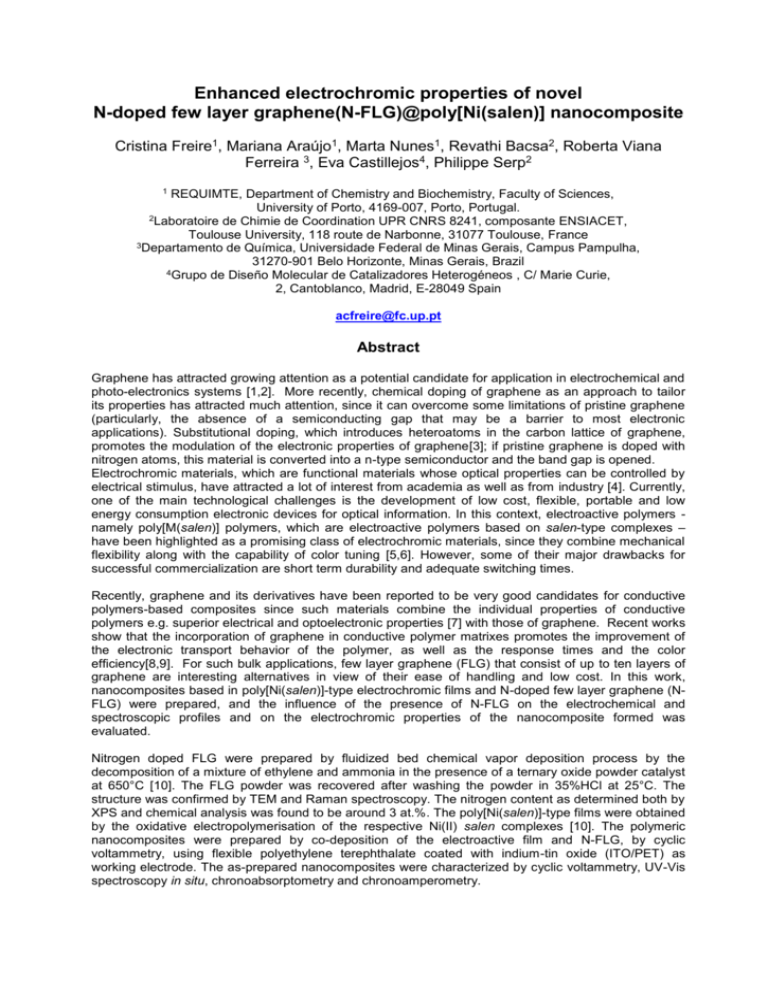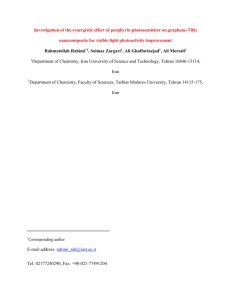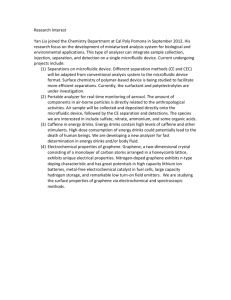Spin polarized transport in semiconductors – Challenges for
advertisement

Enhanced electrochromic properties of novel N-doped few layer graphene(N-FLG)@poly[Ni(salen)] nanocomposite Cristina Freire1, Mariana Araújo1, Marta Nunes1, Revathi Bacsa2, Roberta Viana Ferreira 3, Eva Castillejos4, Philippe Serp2 1 REQUIMTE, Department of Chemistry and Biochemistry, Faculty of Sciences, University of Porto, 4169-007, Porto, Portugal. 2Laboratoire de Chimie de Coordination UPR CNRS 8241, composante ENSIACET, Toulouse University, 118 route de Narbonne, 31077 Toulouse, France 3Departamento de Química, Universidade Federal de Minas Gerais, Campus Pampulha, 31270-901 Belo Horizonte, Minas Gerais, Brazil 4Grupo de Diseño Molecular de Catalizadores Heterogéneos , C/ Marie Curie, 2, Cantoblanco, Madrid, E-28049 Spain acfreire@fc.up.pt Abstract Graphene has attracted growing attention as a potential candidate for application in electrochemical and photo-electronics systems [1,2]. More recently, chemical doping of graphene as an approach to tailor its properties has attracted much attention, since it can overcome some limitations of pristine graphene (particularly, the absence of a semiconducting gap that may be a barrier to most electronic applications). Substitutional doping, which introduces heteroatoms in the carbon lattice of graphene, promotes the modulation of the electronic properties of graphene[3]; if pristine graphene is doped with nitrogen atoms, this material is converted into a n-type semiconductor and the band gap is opened. Electrochromic materials, which are functional materials whose optical properties can be controlled by electrical stimulus, have attracted a lot of interest from academia as well as from industry [4]. Currently, one of the main technological challenges is the development of low cost, flexible, portable and low energy consumption electronic devices for optical information. In this context, electroactive polymers namely poly[M(salen)] polymers, which are electroactive polymers based on salen-type complexes – have been highlighted as a promising class of electrochromic materials, since they combine mechanical flexibility along with the capability of color tuning [5,6]. However, some of their major drawbacks for successful commercialization are short term durability and adequate switching times. Recently, graphene and its derivatives have been reported to be very good candidates for conductive polymers-based composites since such materials combine the individual properties of conductive polymers e.g. superior electrical and optoelectronic properties [7] with those of graphene. Recent works show that the incorporation of graphene in conductive polymer matrixes promotes the improvement of the electronic transport behavior of the polymer, as well as the response times and the color efficiency[8,9]. For such bulk applications, few layer graphene (FLG) that consist of up to ten layers of graphene are interesting alternatives in view of their ease of handling and low cost. In this work, nanocomposites based in poly[Ni(salen)]-type electrochromic films and N-doped few layer graphene (NFLG) were prepared, and the influence of the presence of N-FLG on the electrochemical and spectroscopic profiles and on the electrochromic properties of the nanocomposite formed was evaluated. Nitrogen doped FLG were prepared by fluidized bed chemical vapor deposition process by the decomposition of a mixture of ethylene and ammonia in the presence of a ternary oxide powder catalyst at 650°C [10]. The FLG powder was recovered after washing the powder in 35%HCl at 25°C. The structure was confirmed by TEM and Raman spectroscopy. The nitrogen content as determined both by XPS and chemical analysis was found to be around 3 at.%. The poly[Ni(salen)]-type films were obtained by the oxidative electropolymerisation of the respective Ni(II) salen complexes [10]. The polymeric nanocomposites were prepared by co-deposition of the electroactive film and N-FLG, by cyclic voltammetry, using flexible polyethylene terephthalate coated with indium-tin oxide (ITO/PET) as working electrode. The as-prepared nanocomposites were characterized by cyclic voltammetry, UV-Vis spectroscopy in situ, chronoabsorptometry and chronoamperometry. The as-prepared polymeric films showed a polyelectrochromic behaviour, changing their colours between yellow, green and russet (figure 1). The electrochemical characterisation revealed higher electroactive surface coverage for the film co-deposited with N-FLG, and the spectroscopic data showed some changes in electronic band profiles, when compared to the film without N-FLG; these observations confirm the incorporation of the nanomaterial within the polymeric matrix. The incorporation of the N-FLG within poly[Ni(salen)] film resulted in a nanocomposite with enhanced electrochromic properties. This new material showed lower switching rates (figure 2) and higher optical contrasts (35.9 %) and colour efficiencies (108.9 cm2 C-1) than the pristine poly[Ni(salen)] film (22.1 % and 95.4 cm2 C-1), as well as an improved electrochemical stability, losing only 11.5 % of current intensity after 10 000 redox cycles (11 days of continuous activity). More details on the materials properties and spectroelectrochemical characterisation of these composites will be presented in the poster. Acknowledgments This work was funded by FCT and FEDER through grants no. PEst-C/EQB/LA0006/2011 and Operation NORTE-07-0124-FEDER-000067 – NANOCHEMISTRY through FEDER and CCDRN. MA and MN thank FCT for their PhD grants (SFRH/BD/89156/2012 and SFRH/BD/79171/2011, respectively). RB and PS acknowledge financial support from the European Program POCO (Large scale collaborative project Grant agreement no.: CP-IP 213939-1) and ARKEMA FRANCE. References 1. 2. 3. 4. 5. 6. 7. 8. 9. 10. Hou, J., Shao, Y., Ellis, M. W., Moore, R. B., Yi, B., Physical Chemistry Chemical Physics, 13 (2011) 15384-15384. Pumera, M., Chemical Society Reviews, 39 (2010) 4146-4157. Wang, H., Maiyalang, T., Wang, X., ACS Catalysis 2 (2012) 781-794. Mortimer, R. J., Annual Review of Materials Research 41 (2011) 241-243. Gunbas, G., Toppare, L., Chemical Communications. 48 (2012) 1083-1101. Branco, A., Pinheiro, C., Fonseca J., Tedim, J., Carneiro, A., Parola, A. J., Freire, C., Pina, F., Electrochemical Solid-State Letters 13 (2010) J114-J118. Österholm, A., Lindfors, T., Kauppila, J., Damlin, P., Kvarnström, C., Electrochimica Acta 83 (2012) 463–470. Reddy, B. N., Deepa, M., Joshi, A. G., Srivastava, A. K., The Journal of Physical Chemistry C 115 (2011) 18354–18365. Sheng, K., Bai, H., Sun, Y., Li, C., Shi, G., Polymer 52 (2011) 5567–5572. Bacsa, R.R, Serp, P., WO 2013093350A1. Figures 30.8 s 49.3 s 0.4 /mA i 1.3 V 0.2 i / a.u. 0.6 V 8.69 s 11.4 s 0.0 0.0 V -0.2 -0.4 -0.4 50 0.0 0.4 0.8 1.2 E /V (vs Ag/AgCl) Figure 1. Redox switching of the asprepared N-graphene@poly[Ni(salen)] nanocomposite 100 150 200 t /s Figure 2. Comparative chronoamperograms of poly[Ni(salen)] film with (red) and without N-graphene nanocomposite (black), with the respective response times.






